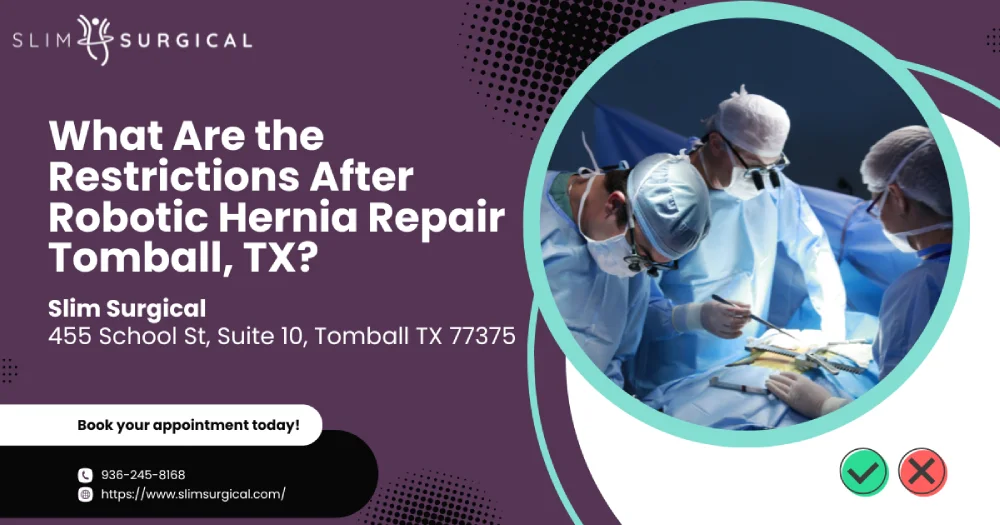
If you are planning for, or recovering from, robotic hernia repair in Tomball, TX, it's important to understand the activity restrictions and recovery process for optimal healing. Robotic hernia surgeries are minimally invasive procedures that use advanced robotic surgical technology to treat various types of hernia, including inguinal hernia, ventral hernia, and even hiatal hernia. The success of your hernia repair surgery and your return to daily routines in Tomball, TX 77375 will depend on following your hernia surgeon's guidance and adhering to specific restrictions after your operation.
Whether you underwent robotic hernia surgery at a Tomball surgical center, the Houston Hernia Center, or opted for robotic hernia repair in Houston, this guide explains what you need to know about activity restrictions, hernia repair pain, and how a minimally invasive and robotic hernia surgery differs compared to traditional open surgery or even laparoscopic hernia repair.
Robotic hernia repair is a minimally invasive surgical procedure that offers several advantages over traditional open surgery, including less hernia repair pain and a faster recovery. After surgery in Tomball or robotic hernia repair in Houston, most patients notice mild discomfort or soreness at the hernia site, which typically responds well to over-the-counter pain medications. Open hernia surgery or complex hernia repair may require additional downtime and monitoring.
In the first few days, your surgeon and medical team will highlight important restrictions you must follow to promote healing and reduce the risk of hernia recurrence. Your surgical experience may vary based on the type of hernia you have—such as inguinal hernia, incisional hernia, ventral hernia, or the less common hiatal hernia. Each hernia repair surgery in Tomball comes with custom recommendations based on the size of the hernia, your age, and other health factors.
The recovery time after robotic hernia repair surgery is typically shorter than traditional open hernia repair or laparoscopic hernia repair. However, activity restrictions are still crucial for success. Patients who had slim surgical or minimally invasive procedures, such as laparoscopic or robotic hernia, often start gentle walking soon after the procedure, assisting blood flow and helping prevent clots.
| Activity | When Is It Allowed? | Comments |
|---|---|---|
| Light Walking | Day of or day after surgery | Encouraged for improved circulation and reducing stiffness; especially important for patients after minimally invasive and robotic hernia surgeries |
| Desk Work | 2–5 days post-op | Often possible for many hernia surgery patients; avoid if still requiring strong pain meds or experiencing significant hernia repair pain |
| Driving | 2–7 days post-op | Ensure ability to react and move safely; do not drive under narcotics after hernia surgery |
| Heavy Lifting (>15 lbs) | 2–6 weeks post-op | Wait for clearance, especially after open hernia or complex hernia repair to reduce the risk of hernia recurrence |
| Strenuous Exercise | 4–6 weeks post-op | Includes high-impact activities, weight training, and abdominal workouts |
| Contact Sports | 4–8 weeks post-op | Obtain explicit approval from your hernia surgeon, especially after inguinal hernia surgery in Tomball or the Houston area |
Your return to work after hernia repair in Tomball (or hernia repair in Houston) will depend on a range of factors, including the type of hernia repair, the demands of your job, and your overall health. Most sedentary office roles allow for a return within a week of minimally invasive surgery, while those with physically demanding jobs—such as lifting, manufacturing, or delivery—may need extra healing time. Those recovering from robotic hernia repair surgery generally experience a smoother transition back to work compared to traditional open hernia repair patients.
Patients in Tomball should communicate closely with their surgeon. Some may need to delay returning to demanding work environments, especially after a complex incisional hernia or ventral hernia repair using advanced robotic surgical techniques. Your hernia repair in Tomball plan will be personalized to your case and the specific type of hernia surgery performed.
Whether recovering from robotic hernia, laparoscopic hernia repair, or open repair, individualized care is crucial. Recovery through hiatal hernia repair or after inguinal hernia surgery in Tomball will have unique timelines.
Proper wound care is vital after all forms of hernia surgery recovery, including open hernia surgery, minimally invasive hernia repairs, and robotic hernia surgery. Showering is usually permitted 24–48 hours after robotic or laparoscopic hernia procedures, but soaking in tubs or swimming should still be avoided for 1–2 weeks. This helps reduce infection risk and encourages a smooth recovery in Tomball.
Different types of incision care may be needed depending on whether you had open inguinal hernia repair, robotic-assisted hernia repair, laparoscopic or robotic surgery, or even repair surgery if you live in the broader Houston area.
Robotic techniques and minimally invasive hernia repairs offer Texas patients—especially in Tomball and Houston—a route to less pain and faster recovery. However, compliance with activity restrictions and surgeon recommendations is critical to maximize these advantages.
If you notice fever, severe hernia repair pain, new swelling, or bleeding at the hernia site, seek medical advice immediately. Quick action reduces your risk of hernia recurrence or serious surgical complications.
To enhance recovery after hernia repair surgery in Tomball, combine expert surgical care with practical home steps. Patients who actively engage in their recovery—by moving gently, eating nutritiously, and seeking support—usually experience less downtime and better outcomes after robotic hernia surgery or other minimally invasive hernia procedures.
Your post-operative mindset and communication with your hernia surgeon matter as much as the latest minimally invasive and robotic technology. If you have concerns about pain, activity, or your recovery time, always reach out to your surgical team at Slim Surgical or your provider at 455 School St in Tomball, TX 77375. Open and prompt communication can reduce the risk of hernia recurrence and ensure the best outcome after your hernia repair surgery.
Recovering from robotic hernia repair in Tomball, TX—or after any hernia surgeries—offers many advantages, including pain and faster recovery through modern minimally invasive and robotic techniques. While returning to your normal activities is the goal, following activity restrictions, respecting your surgical repair, and keeping in touch with your hernia specialist or the Houston Robotic Hernia Surgery clinic is the safest path to a full recovery.
For questions or to discuss options in Tomball for laparoscopic and robotic hernia repairs, or to learn more about the right hernia repair in Tomball for your needs, the hernia surgeons at Slim Surgical are ready to help residents of Tomball, Houston, and the surrounding Texas communities get back to life with confidence.
After robotic hernia repair, you should avoid heavy lifting and strenuous exercise for at least 2–4 weeks to prevent strain on the surgical site. Light activities like walking are encouraged to promote circulation and reduce complications. Always follow your surgeon’s guidance for driving, bathing, and wound care to ensure a safe and smooth recovery.
Robotic hernia repair can address a range of hernia types, including inguinal hernia, ventral hernia, hiatal hernia, and incisional hernia. Your hernia surgeon will decide if robotic or open surgery—or a minimally invasive laparoscopic approach—is best for your specific situation in Tomball, TX.
Yes, many complex hernia repairs can be successfully performed using minimally invasive and robotic surgical techniques. Robotic technology offers greater dexterity, making it ideal for challenging cases seen at Tomball surgical centers or Houston hernia specialists.
Resuming weightlifting or other strenuous activity typically occurs 4–6 weeks after robotic hernia repair. Your exact return is determined by your hernia surgeon’s assessment, the size of the hernia, and your progress during recovery in Tomball, TX.
Robotic hernia surgeries—like other minimally invasive hernia repairs—often lead to improved outcomes. Proper techniques, experienced surgical teams, and following post-surgical restrictions all help reduce the risk of hernia recurrence after your procedure.
Normal healing includes decreasing discomfort, minimal swelling, and healthy-looking incision sites. Redness, fever, severe hernia repair pain, or unusual drainage may signal complications. Contact your Tomball surgical team promptly if you notice any troubling symptoms after your hernia surgery.
Most insurance plans cover medically necessary hernia repair surgery, including minimally invasive and robotic hernia surgery. It's important to confirm specific coverage for your hernia type and to discuss billing with your surgeon's tomball or Houston office for clarity.
Minimally invasive and robotic hernia repairs typically offer less pain, smaller scars, faster recovery time, and reduced infection risk in comparison to open repair. This is why many hernia patients in Tomball and surrounding TX communities ask their surgical team about these modern options.
Recovery through hiatal hernia repair may involve different dietary and physical restrictions compared to inguinal hernia surgery. Hiatal hernia occurs in the upper stomach, so patients may have diet and swallowing guidance in addition to typical hernia surgery recovery care in Tomball.
Yes, minimally invasive and robotic hernia repairs can be an excellent option for treating recurrent hernias. Your hernia surgeon at Slim Surgical will evaluate previous repairs, the type of hernia, and recommend the safest surgical procedure for you in Tomball, TX.
Patients in Tomball, Houston, and across TX should look for board-certified hernia surgeons with expertise in minimally invasive surgery, laparoscopic and robotic hernia repair. Slim Surgical at 455 School St is a trusted choice for comprehensive hernia care and recovery in Tomball, TX 77375.

Start your journey toward health and confidence with Slim Surgical. Our expert surgeon is here to guide you every step of the way with advanced care tailored to your goals.

2025 Slim Surgical. All right reserved. Website Design & SEO By: Authority Solutions®